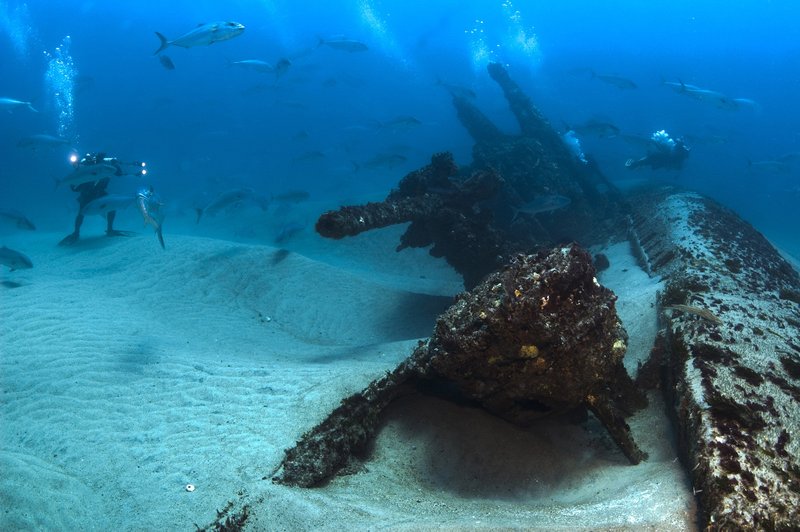WASHINGTON -- In 1942, 13-year-old Jean Revels lost her father, Capt. Anders Johanson, to a torpedo attack from a German U-Boat.
"My dad went down with the ship and saved all his men," Revels, now 87, recalled from her home in Charleston, S.C.
Johanson was captain of the SS Dixie Arrow, an American oil tanker sunk off the coast of Cape Hatteras, N.C., on March 26, 1942. Ninety other ships met similar fates off Cape Hatteras, turning the area into the "Graveyard of the Atlantic" and the only American World War II battlefield.
"It's a burial ground, their tomb, to honor where their last moments living were," said Dale Revels, Jean's son and Johanson's grandson.
Preserving the submerged military graveyard is the goal of a proposal from the National Oceanic and Atmospheric Administration to expand the existing Monitor National Marine Sanctuary, which protects the site where the Civil War battleship USS Monitor went down, to include the World War II shipwrecks.
But that idea, first raised in 2014, has met opposition from North Carolina officials and residents who fear that further regulation of the waters will cut into livelihoods dependent on tourism and fishing.
"Our concern is not for today but for tomorrow," said Warren Judge, a member of the Dare County Board of Commissioners, which has gone on record against the proposal. "Our experience has been that within 40 to 50 years we will be prohibited to use the sanctuary, and so we are concerned for our future generations' access to use the resource."
Tane Casserley, a marine archaeologist and the research coordinator for the Monitor sanctuary, says the concerns are misplaced. People will still be allowed to dive and fish in the expanded sanctuary, he said. What they won't be able to do is take artifacts off the ships or otherwise damage them.
It was Jean Revels' discovery in 1998 that the bell of the Dixie Arrow was hanging as a trophy in a Cape Hatteras dive shop that gave rise to the proposal for a sanctuary.
She was appalled at what she felt was the equivalent of grave robbing and began a letter-writing campaign to protect the final resting place of Merchant Marine vessels. NOAA finally proposed the expansion in June 2014.
"We need to protect this as a battlefield and a monument for the fallen sailors of the war," Casserley said. Under current federal law, only about six of the 91 wrecks are protected, he said.
David Alberg, the superintendent for the Monitor sanctuary, says a final proposal is in the works, now that the public comment period, which closed March 18, has ended. The final plan, he pledged, will take in public concerns expressed in those comments and gathered during five hearings -- four in North Carolina and one in Washington.
The final proposal "is about working together to honor this history, in so doing showcasing the heritage and appreciation of the role North Carolina played in World War II," Alberg said.
"Not many Americans know about it," he added, "and it needs to be honored."
Author Ed Offley, who has written two books about the role of German U-Boats in World War II and the Battle of the Atlantic, thinks the government is going in the right direction to expand the sanctuary.
"Most of these ships are grave sites," Offley said.
But residents who make their livings from the sea are less interested in the dead than in preserving their livelihoods.
"I don't trust NOAA. I don't trust the government, as they will do whatever they want with or without permission," said Mike Warren, owner and operator of Hatteras Blue Fishing Charters in Hatteras, N.C.
He said others who make their livelihoods from the sea -- tackle shops, restaurants workers, fishermen, charter boat captains and more -- share his concern.
"When they get their hands on something, more things always come," he said, referring to federal officials and regulations.
Jim Bunch, a Kill Devil Hills, N.C., resident who represents recreational diving on the Monitor Advisory Council, is not against expanding the Monitor sanctuary "as long as NOAA follows through with what they are planning to do."
But he also understands others' trepidations. "The fishing industry has had a rough past, so they are less trustful," he said.
Alberg pledged that the opposition's "totally reasonable concern" will be taken into account.
"NOAA is aware of the concern from the fisherman and local citizens as their livelihoods are mainly from the Outer Banks," Alberg said. "We are aware of it, we are being sensitive about it."
The Cape Hatteras sanctuary isn't the first to face opposition. When NOAA proposed the Thunder Bay sanctuary in Lake Huron in Michigan in 1991, it met local opposition -- the nearby city of Alpena in 1997 even voted in a referendum to oppose the sanctuary.
But the opposition was eventually overcome with a revised proposal, and in 2000 the sanctuary was established.
For the Revels family, the establishment of a Cape Hatteras sanctuary would end a yearslong search for recognition of a nearly forgotten chapter in U.S. history.
"My grandfather went down with the ship," said Dale Revels. "The crew managed to escape, but all of the officers went down with the ship, and there really isn't a memorial for them.
"NOAA is just trying to preserve a historical graveyard like Gettysburg or Normandy, to preserve the historic efforts of these men."
SundayMonday on 04/17/2016
